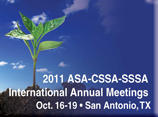 |
| {Photo from https://www.acsmeetings.org} |
This year Apogee is sponsoring two workshops prior to the meetings with Decagon Devices. The workshops are “Soil Moisture and Hydraulic Properties Measurement Instrumentation Theory, Application, and Hands-on Training” and “Plant Measurements from Leaf to Canopy: Light and Temperature Interaction.” Apogee has sponsored workshops in the past with Decagon and these have proven to be great experiences to work with researchers using a variety of instruments from several companies.
One of the things I like best about tradeshows and annual meetings is the interaction with customers. Many times marketing consists of putting out information unidirectionally. Print ads, websites and many other marketing avenues do not allow us to engage with our customers and discover if the intended concept was received correctly. Tradeshows allow us to do this, which in turn leads to improvements in how we communicate through our website and other medium.
At this year’s meeting we will be introducing an aspirated radiation shield, a hand-held meter for our infrared sensor and a new field-of-view option for our infrared sensor. We have also developed a 4 – 20 milliAmp output for our solar radiation sensors. We look forward meeting you at this year’s meeting. Please stop by booth 606 and say hello.
* ASA combines each year with the Crop Science Society of America (CSSA) and the Soil Science Society of America (SSSA) for their annual meetings. We used the letters ASA to make the post more concise. We are excited to join with the Canadian Society of Soil Science for this years meeting.
Devin Overly
General Manager









